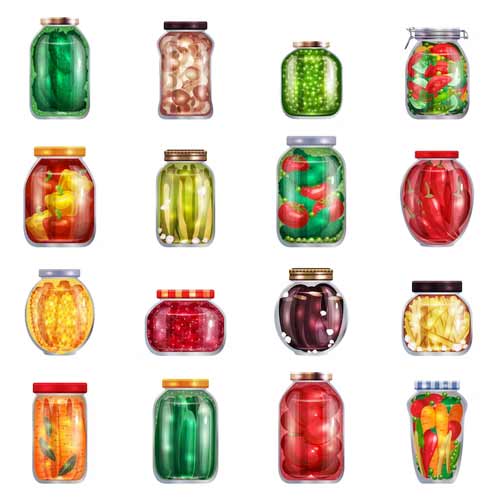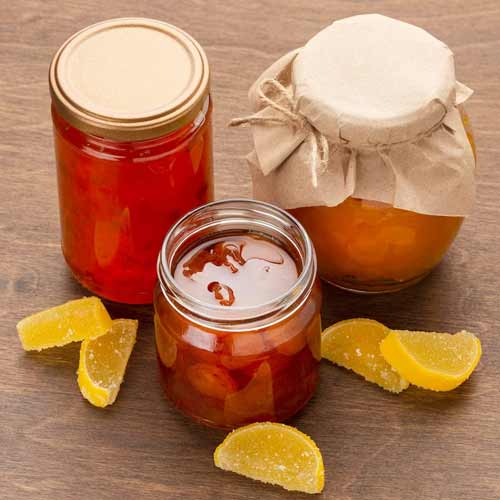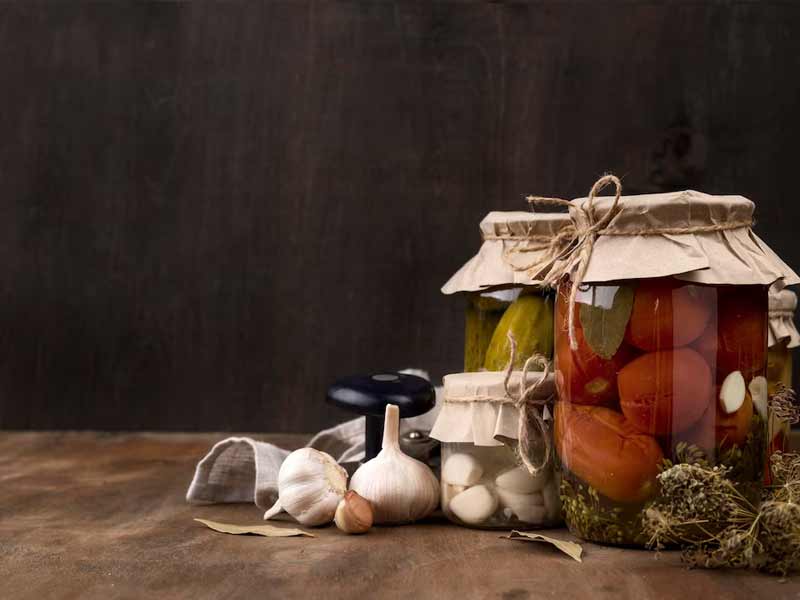Here are Types of Canning. Looking to embark on a canning adventure? Our meta description introduces you to 5 different types of canning, providing insights into their unique processes and benefits.
Canning is a time-honored method of preserving food that has been practiced for centuries. It allows us to enjoy the flavors of summer fruits and vegetables all year round. In this article, we will explore the various types of canning techniques that you can use to preserve your favorite foods. From water bath canning to pressure canning, we will cover it all. So, let’s dive in and discover the art of canning!
What is Canning?
Canning is a food preservation method that involves sealing food in airtight containers to prevent spoilage and extend its shelf life. It is a popular technique used by home cooks and food manufacturers to preserve seasonal fruits, vegetables, and other perishable foods for long-term storage. The process of canning involves heat processing the food in the container to kill or inactivate microorganisms, enzymes, and other potentially harmful substances that could cause spoilage or foodborne illnesses.
The primary goal of canning is to create a sealed environment that prevents the growth of bacteria, yeasts, and molds, thereby preserving the quality and safety of the food. Canned foods are typically shelf-stable and can be stored at room temperature for an extended period, often ranging from several months to several years. You can Learn Benefits of Canning.

There are two main methods of canning: water bath canning and pressure canning. Water bath canning is suitable for high-acid foods such as fruits, pickles, and jams, as the high acidity helps prevent the growth of bacteria. Pressure canning is used for low-acid foods such as vegetables, meats, poultry, and soups, as they require higher temperatures to ensure safety.
The canning process involves several key steps (Types of Canning). First, the food is prepared by washing, peeling, and trimming as necessary. Jars, lids, and bands are cleaned and sterilized to maintain cleanliness. The prepared food is then packed into the sterilized jars, leaving appropriate headspace. Lids and bands are placed on the jars, and they are tightened securely. The filled and sealed jars are then processed using the appropriate canning method for the specific food. This processing step involves heating the jars to destroy any microorganisms or enzymes that could cause spoilage. Finally, the jars are allowed to cool, and the seal is checked to ensure proper closure.
Canning allows individuals to enjoy the flavors of fresh produce throughout the year and reduces food waste by preserving excess harvests. It is important to follow proper canning procedures, including using reliable recipes, maintaining cleanliness, and ensuring proper processing times and temperatures, to ensure the safety and quality of the canned foods. By practicing safe canning techniques, individuals can enjoy the convenience of pantry-stocked foods while preserving the nutritional value and flavors of seasonal produce.
Types of Canning: Exploring Your Options

1. Water Bath Canning: Preserving High-Acid Foods
Water bath canning is a popular method used to preserve high-acid foods such as fruits, jams, jellies, and pickles. The process involves submerging sealed jars in boiling water for a specific period of time. The high heat kills bacteria, yeasts, and molds, ensuring the safety and longevity of the preserved food. It is important to note that water bath canning is not suitable for low-acid foods, as they require a higher temperature for preservation. This is one of the Types of Canning. You can learn Troubleshooting Canning.
2. Pressure Canning: Preserving Low-Acid Foods
Unlike water bath canning, pressure canning is necessary for preserving low-acid foods such as vegetables, meats, and soups. Low-acid foods require a higher temperature than what can be achieved with water bath canning. A pressure canner creates a high-pressure environment, reaching temperatures above the boiling point of water. This ensures that harmful bacteria such as Clostridium botulinum are destroyed, preventing the risk of botulism. This is one of the Types of Canning.
3. Steam Canning: An Alternative to Water Bath Canning
Steam canning (Types of Canning) is a relatively new method that offers an alternative to traditional water bath canning. It uses steam to heat the jars and seal them, eliminating the need for a large pot of boiling water. Steam canners are quicker to heat up and use less water, making them more energy-efficient. However, it is essential to follow the manufacturer’s instructions carefully when using a steam canner to ensure proper preservation. This is one of the Types of Canning. You can learn Steam Canning.
4. Raw Pack vs. Hot Pack: Choosing Your Method (Types of Canning)
When canning, you have the option of using either the raw pack or hot pack method, depending on the type of food you are preserving. The raw pack method involves filling jars with raw, uncooked food and then adding hot liquid (such as syrup or brine) before sealing. On the other hand, the hot pack method requires pre-cooking the food before filling the jars. Both methods have their advantages, and the choice depends on the specific food being preserved and personal preference. This is one of the Types of Canning.
5. Open Kettle Canning: Not Recommended
Open kettle canning is a historical method of canning that involves pouring hot food directly into jars and sealing them without any further processing. However, this method is no longer recommended due to safety concerns. Open kettle canning does not provide the necessary heat treatment to destroy bacteria and can lead to spoilage or foodborne illnesses. It is crucial to use safe and tested canning methods to ensure the preservation of food. This is one of the Types of Canning.
6. Pickling: Preserving with Vinegar
Pickling is a popular form of canning that involves preserving food in a solution of vinegar, water, salt, and sugar. The acidity of the vinegar creates an inhospitable environment for bacteria and helps prolong the shelf life of the preserved food. Pickling can be done using both water bath canning and pressure canning methods, depending on the acidity of the food being pickled. This is one of the Types of Canning. You can learn Storing Canned Food.
Frequently Asked Questions (FAQs) – Types of Canning
FAQ 1: Can I reuse canning lids?
No, it is not recommended to reuse canning lids. The sealing compound on the lids becomes compromised during the initial use, making it less effective in subsequent uses. Reusing lids can lead to improper sealing, which increases the risk of food spoilage and contamination. It is best to use new lids for each canning session to ensure the safety and quality of your preserved food.
FAQ 2: Can I adjust canning recipes to suit my taste preferences?
While it may be tempting to adjust canning recipes to suit your taste preferences, it is essential to follow tested and approved recipes precisely. Canning recipes are carefully formulated to ensure the proper balance of acidity, ingredients, and processing times for safe preservation. Modifying recipes without expert knowledge can alter the pH level and processing requirements, compromising the safety and quality of the preserved food.
FAQ 3: How long can canned food be stored?
When properly preserved and stored, canned food can last for an extended period, even up to several years. However, it is recommended to consume home-canned food within one year for the best quality and flavor. Over time, the nutritional value of the food may deteriorate, and the texture and taste may change. It is important to regularly inspect canned food for any signs of spoilage, such as bulging lids, off-putting odors, or unusual colors, and discard any cans that show such signs.
FAQ 4: What are the signs of spoilage in canned food?
The signs of spoilage in canned food include bulging or swollen lids, leaking or seeping liquid, off-putting odors, mold growth, unusual colors, and hissing or popping sounds upon opening the jar. If you notice any of these signs, do not consume the canned food as it may be contaminated and pose a health risk. It is crucial to prioritize safety when it comes to canned food.
FAQ 5: Can I store canned food without refrigeration?
Canned food does not require refrigeration as long as the cans are properly sealed and stored in a cool, dry place. The high heat used during the canning process kills bacteria and creates a vacuum seal, preventing spoilage. However, once a can is opened, any remaining food should be promptly refrigerated and consumed within a few days. You can learn Canning Safety.
FAQ 6: Are there any safety precautions I should follow when canning?
Yes, there are several safety precautions to keep in mind when canning:
- Always use tested and approved canning recipes.
- Ensure your equipment, including jars, lids, and canners, is in good condition.
- Follow the recommended processing times and temperatures for each type of food.
- Use proper canning techniques, such as correct headspace, to allow for expansion during processing.
- Allow the jars to cool naturally and check the seals before storing.
- Regularly inspect canned food for signs of spoilage and discard any questionable jars.
Conclusion for Types of Canning

Canning is a wonderful way to preserve the flavors of seasonal produce and enjoy them throughout the year. Whether you choose water bath canning, pressure canning, or other methods like steam canning or pickling, the key is to follow safe and tested techniques to ensure the quality and safety of your preserved food (Types of Canning). With proper precautions and attention to detail, you can embark on a journey of preserving your favorite fruits, vegetables, and more. Happy canning!
We proudly present: 1TouchFood, a website specifically designed for online cooking education. Our platform offers a diverse range of culinary tutorials, aimed at teaching aspiring chefs and cooking enthusiasts the art of cooking from the comfort of their own homes. Whether you’re a beginner or an experienced cook looking to expand your culinary repertoire, 1TouchFood provides step-by-step video lessons, interactive recipes, and expert tips to enhance your cooking skills.
Our dedicated team of professional chefs and culinary experts have meticulously crafted each lesson to ensure a seamless and immersive learning experience. Join us on 1TouchFood and unlock your potential in the kitchen as you embark on a culinary journey filled with flavors, techniques, and newfound inspiration.
Please follow us on linkedin. You can learn all best canadian food recipes you can check our Culinary 1TouchFood Youtube and Telegram 1TouchFood page. Don’t forget Fighting Obesity Magazine and Radio Cooking.

